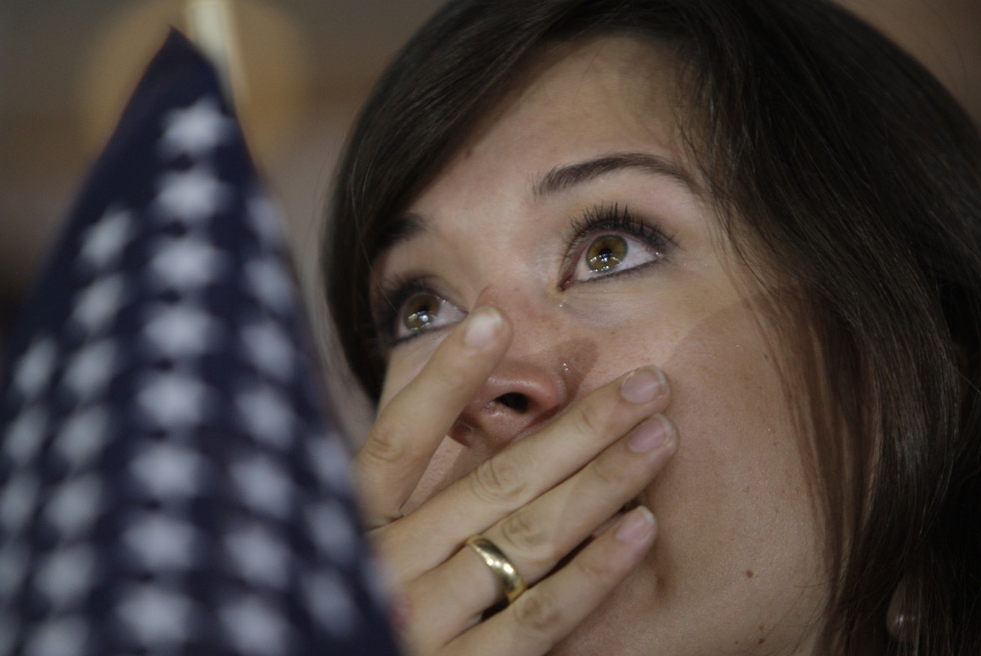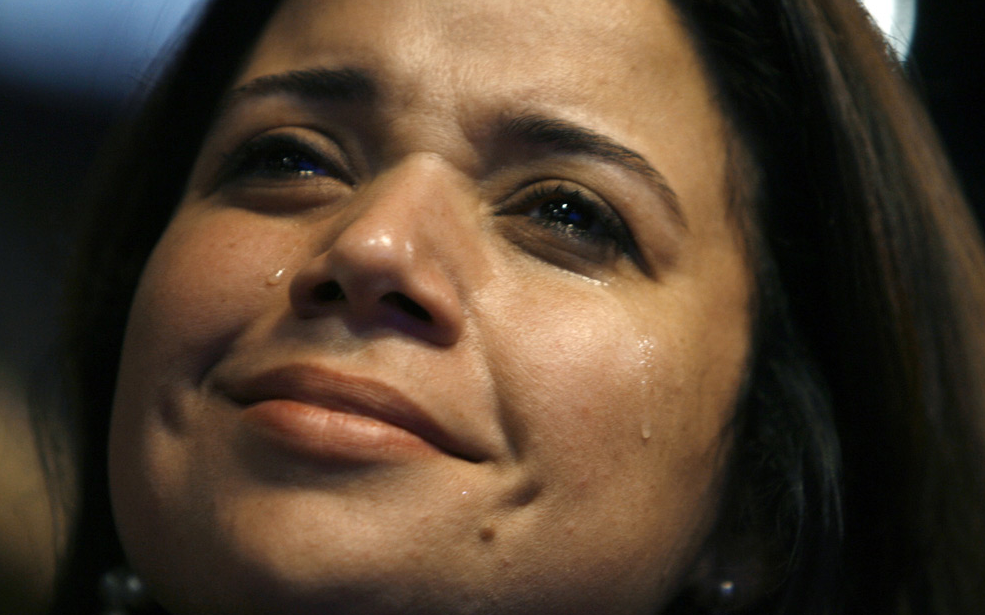A recent slide show at The Big Picture on the 2008 Political Conventions consists of thirty-six photographs oscillating back and forth between the events that took place first in Denver and then in Minneapolis. And what we see, quite clearly, are nearly identical, highly ritualized media events. Most of the pictures are of crowds cheering on their respective candidates or of the candidates and their families themselves. Two images call attention to protestors (interestingly enough both are from the Minneapolis Convention as if there were no protests in Denver) and, as has become the custom in recent years, several images reflexively call attention to the presence of the media itself. What I found most interesting, however, were these two photographs:
Nearly identical images, their captions accent the relevant theme as each describes a woman/delegate “crying” in the presence of the acceptance speech of her chosen candidate. Their passion in each case is palpable and intense, as each woman/delegate looks up to what we can only assume she sees as her political savior. It is the expression of awe one might imagine in the presence of an overwhelming and sublime power, what Max Weber might have called “charisma.” And regardless of what one might think of either candidate, the point here seems to be that the expression of such affect is an inherent part of the political process, an authentic component of the ritual of political identification. Indeed, one would be hard pressed to say which is the Democrat and which is the Republican.*
The very way in which the photographs are framed seems to be telling in this regard. Shot from below and in extreme tight focus the images are cropped to exclude almost all signs or symbols that might distinguish and underscore party affiliation or opposition. Even the two markers of institutional affiliation in the top image – the shield of the U.S. flag in soft focus and the gold wedding band on her hand – call attention to ambiguously normative and largely homogeneous identifications. Republican or Democrat, the images seem to suggest, it doesn’t matter, the expression of emotion in public is inimical to our political being. As such, these two women are something like visual synecdoches for the body politic.
But there is more, for the expression of emotion that they privilege is not only clearly gendered feminine (we don’t see men crying for joy in the images of this slide show, nor do we tend to find them anywhere … and when we do find something comparable, as say with Howard Dean’s famous verbal “cry” for joy four years ago in Des Moines, Iowa, it is clearly vilified as inappropriate and “out of control”), but it is also portrayed in highly privatized terms. Crying, in the western world at least, is typically an individual, not a communal, behavior, and it is generally seen as the expression of a deeply personal, individual psychic state that is more or less anathema to good public policy. The implication here, then, is that such emotional responses are fine—perhaps even to be encouraged as a antidote to apathy and alienation— so long as they are socially disciplined and restrained. And here notice how the woman in the first image wipes away her tears, almost as if to hide them from the outside world, and the woman in the second image seems to be clenching her facial muscles as if to hold the tears back.
One can cry in public, it seems, but to do so is to isolate oneself in some measure from the polity; it is to turn inwards in ways that divorces our “liberal” sensibilities from our “democratic” sensibilities, and in so doing nullifies the otherwise potent potentialities for a genuine “liberal-democracy.” And it is precisely in this sense that the framing of the two photographs fully isolates these women as individuals from the thousands of delegates surrounding them, as well as the synesthesia of collective activity—the chanting and clapping and banner waving—that is the hallmark of such occasions.
What these photographs display then is the incredible ambivalence we have to the presence of public emotion. Whereas in one sense these women seem to channel the body politic, in another, and at the same time, they stand as something of a caution to a too close psychic connection between the individual and the collective. And the question for us is how to negotiate an authentic public emotionality that is not oppressively reduced to and restricted by the normative demands of a privatized, bourgeois sensibility.
* The first image is from Denver, the second from Minneapolis.
Photo Credits: L.M. Otero/AP Photo; Damir Sagolj/Reuters


if the first image does include the woman’s wedding ring, it’s been reversed prior to publication, since that’s her right hand in the picture. interesting!
Caroline: How can you tell? Given the angle from which it is shot I would imagine that it could easily be the left hand … In fact, I’ve been trying to reproduce the pose myself. It could be her right hand, but it would be a rather awkward positioning of the arm. The left arm/hand seems to me to make more sense. But help me out here …
It’s definitely her right hand. The dominant index finger’s the one on her nose.
I suspect it IS in fact the left hand and that the photo has been mirrored for practical, aesthetic, editorial purposes. At least then it could be a wedding band.
As for it being an either/or, if it were in fact her left hand and the photo were not reversed, the ring would still be on the wrong finger as it should then be on the finger adjacent to her ‘pinkie’ which we would read as the finger on her nose.
Wouldn’t it be fun if THIS photo had been reversed? Then there could be another editorial lynching of whomever was the guilty party. Of course, it *could* be an honest mistake with a slide or negative set upside down in the scanner …
yeah — her thumb is concealed under the flag, presumably. hold your right hand up in front of your face, palm toward you, about 45 degrees counterclockwise. now put it on your face. that’s her pose.
Actually your explanation works the same for the left hand and it would require an even less awkward pose for the arm. But Gary nails it. If the picture really were reversed the ring would not be where it is (unless its not a wedding ring). Not likely.
You-all beat me to the punch on my first quibble, except it IS her right hand, as in the photo. I don’t understand Lucaities’ reply to Gary, as the pinkie finger is anatomically clear from the picture. Assuming that gold band was worn on the left hand, the photo has been flipped–not uncommon in practice.
But my second quibble is the assertion that permission to cry is gendered feminine in politics. Point one: Hillary was villified for “crying” (although she didn’t really), presumably in order to manipulte voters in N.H. Point two: GHWBush is famously a “cryer” and I do not recall his receiving criticism on this count. Nor Reagan for choking a bit at Bitburg. All in all, the issue of political tears is more nuanced than just gendered, but these photos do demonstrate that crying/emotional engagement may be more permissible among the (feminine?) audience than among leaders. This makes me want to run and re-read James Elkin’s book on emotional viewing of art.
If the second photo is from Minneapolis, she is probably crying at the outrage of someone like Sarah Palin zooming into prominance, and possibly the presidency, on the hard-fought coattails of someone like Hillary Clinton. Sorry, after the pressures of maintaining a neutral pose in the classroom, I just couldn’t resist a bit of political snark.
Janis: I think you are right that the relationship between gender and tears is more complicated than the original post pursues. But I don’t think you quite get at it with your examples. Yes, Hillary cried. And yes she was vilified. That’s the point. Pat Shroeder, back in the day, did the same thing as you no doubt recall. And it ended her run for the presidency. Why? Because in addition to such public crying being gendered female, politics is gendered male. When you do the math it becomes clear (in the cultural logic) that these women are not suited for the jobs they aspire to. I’m not fully familiar with what you claim is GWB’s “famous” crying. But if it is connected to 9/11 and 9/11 affiliated activities, I’d say that that is the exception that proves the rule. So too RR at Bitburg: A “funeral”/”memorial” situation seems to change the dynamic some. It is more “like” a private/domestic moment than a public/political moment (though of course it isn’t) and thus invites a bit more flexibility. So, I’d say yes, it is more complex and I appreciate your pointing it out. But the complexity, I believe, only underscores the fundamental logic.
john–thanks for sharing these images–the visual parallel in age, phenotype, grooming, gender, and posture is striking indeed–esp when i previously thought more attention was given to their visual differences by most (eg the big to-do about the DNC’s “greek” columns).
my recollection is that sen. clinton’s poll numbers went up after the tearing–some vilified her, but some said it was a welcomed sign of her vulnerability and “realness.” nevertheless, i concur with john that tears remain an act that dominant culture still genders in many ways. given the recent palin hype about appealing to senator clinton’s voters by virtue of identifying as a female, it is notable that you identified this emergent icon of the “everyday female voter who is moved.”
John, I meant GHW Bush was the cryer, although I remember this as a habit he proclaimed and demonstrated, but not as any particular instance. Perhaps I missread your initial remarks as allowing for crying as a “feminine” behavior, even on the political stage. Yes, Phaedra, Hillary got some positive response from the public for her verklempt moment, but that was a watershed moment of sexist, negative response in the mainstream media commentary (gendered male…still), as I saw it. More complications: crying for men used to be villified, as with Muskie’s famous “crying in the snow” incident in 88 or thereabouts, but now is more allowed for men leaders, while still problematic for women leaders. Not so with audiences, apparantly.
If the lady is European -maybe German- the wedding band would be at the right hand.